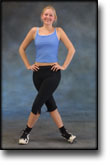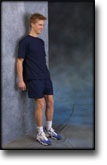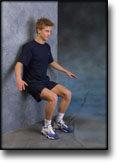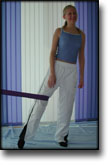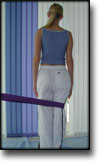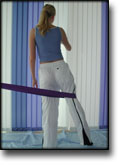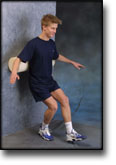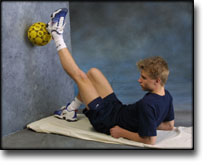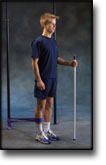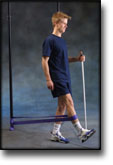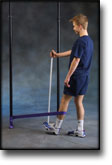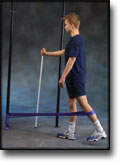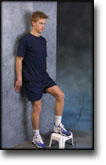|
Revision ACL reconstruction using autogenous patellar tendon graft. |
Alle indlæg af urtehave_com
Week 13-15
Training ladder for:
RUPTURE OF THE POSTERIOR CRUCIATE LIGAMENT
(RUPTURA LIGAMENTUM CRUCIATUM POSTERIUS)
| The following exercises can only be considered as a supplement to the guidelines furnished by the doctor which performed the operation. Specific precautions are necessary as the operation can be complicated. The training must not bring about swelling or pain in the knee. | ||||||||||||||||||||||||||||||||||||||||||||||
| Unlimited: Cycling. Swimming. Light running.
|
||||||||||||||||||||||||||||||||||||||||||||||
|
Stretching is carried out in the following way: stretch the muscle group for 3-5 seconds. Relax for 3-5 seconds. The muscle group should subsequently be stretched for 20 seconds. The muscle is allowed to be tender, but must not hurt. Relax for 20 seconds, after which the procedure can be repeated. The time consumed for stretching, coordination and strength training can be altered depending on the training opportunities available and individual requirements. |
Week 10-12
Training ladder for:
RUPTURE OF THE POSTERIOR CRUCIATE LIGAMENT
(RUPTURA LIGAMENTUM CRUCIATUM POSTERIUS)
| The following exercises can only be considered as a supplement to the guidelines furnished by the doctor which performed the operation. Specific precautions are necessary as the operation can be complicated. The training must not bring about swelling or pain in the knee. | |||||||||||||||||||||||||||||||||||||||||||||||||||||||
| Unlimited: Cycling with raised saddle. Swimming. Light jogging.
|
|||||||||||||||||||||||||||||||||||||||||||||||||||||||
|
Stretching is carried out in the following way: stretch the muscle group for 3-5 seconds. Relax for 3-5 seconds. The muscle group should subsequently be stretched for 20 seconds. The muscle is allowed to be tender, but must not hurt. Relax for 20 seconds, after which the procedure can be repeated. The time consumed for stretching, coordination and strength training can be altered depending on the training opportunities available and individual requirements. |
week1
Training ladder for:
RUPTURE OF THE POSTERIOR CRUCIATE LIGAMENT
(RUPTURA LIGAMENTUM CRUCIATUM POSTERIUS)
| The following exercises can only be considered as a supplement to the guidelines furnished by the doctor which performed the operation. Specific precautions are necessary as the operation can be complicated. The training must not bring about swelling or pain in the knee.
The indications of time after stretching, coordination training and strength training show the division of time for the respective type of training when training for a period of one hour. The time indications are therefore not a definition of the daily training needs, as the daily training is determined on an individual basis. |
||||||||
| (5 min):
|
||||||||
|
Stretching is carried out in the following way: stretch the muscle group for 3-5 seconds. Relax for 3-5 seconds. The muscle group should subsequently be stretched for 20 seconds. The muscle is allowed to be tender, but must not hurt. Relax for 20 seconds, after which the procedure can be repeated. The time consumed for stretching, coordination and strength training can be altered depending on the training opportunities available and individual requirements. |
step4
Training ladder for:
MENISCUS LESION
(LAESIO TRAUMATICA MENISCI)
STEP 4 |
|
|||||||||||||||||||||||||||||||||||||||||||||||||
step3
Training ladder for:
MENISCUS LESION
(LAESIO TRAUMATICA MENISCI)
STEP 3 |
|
|||||||||||||||||||||||||||||||||||||||||||||||||
step2
Training ladder for:
MENISCUS LESION
(LAESIO TRAUMATICA MENISCI)
STEP 2 |
|
|||||||||||||||||||||||||||||||||||||||||||||||||||||
step1
Training ladder for:
MENISCUS LESION
(LAESIO TRAUMATICA MENISCI)
STEP 1 |
|
||||||||||||||||||||||||||||||||||||||||||||||||||||||||||||
treatment-article
|
Placement of intra-articular injections verified by ultrasonography and injected air as contrast medium. |
step4
Training ladder for:
JUMPER’S KNEE
(JUMPER´S KNEE)
STEP 4 |
Unlimited: Cycling. Swimming. Running on a soft surface.
|
|||||||||||||||||||||||||||||||||||||||||||||||||||||||||||||
|
Stretching is carried out in the following way: stretch the muscle group for 3-5 seconds. Relax for 3-5 seconds. The muscle group should subsequently be stretched for 20 seconds. The muscle is allowed to be tender, but must not hurt. Relax for 20 seconds, after which the procedure can be repeated. The time consumed for stretching, coordination and strength training can be altered depending on the training opportunities available and individual requirements. |







